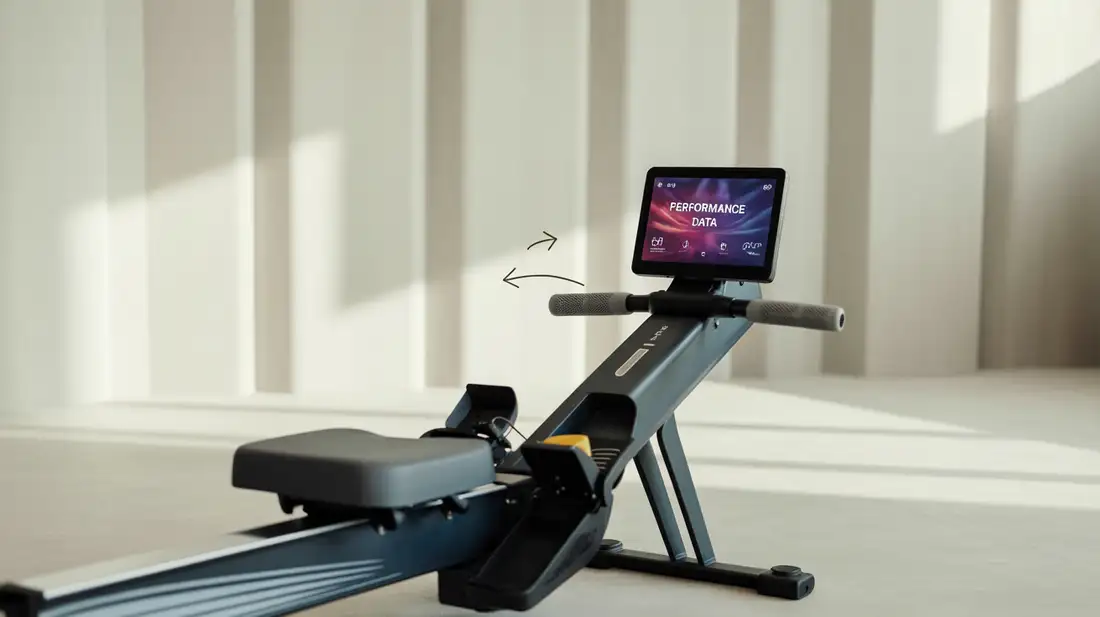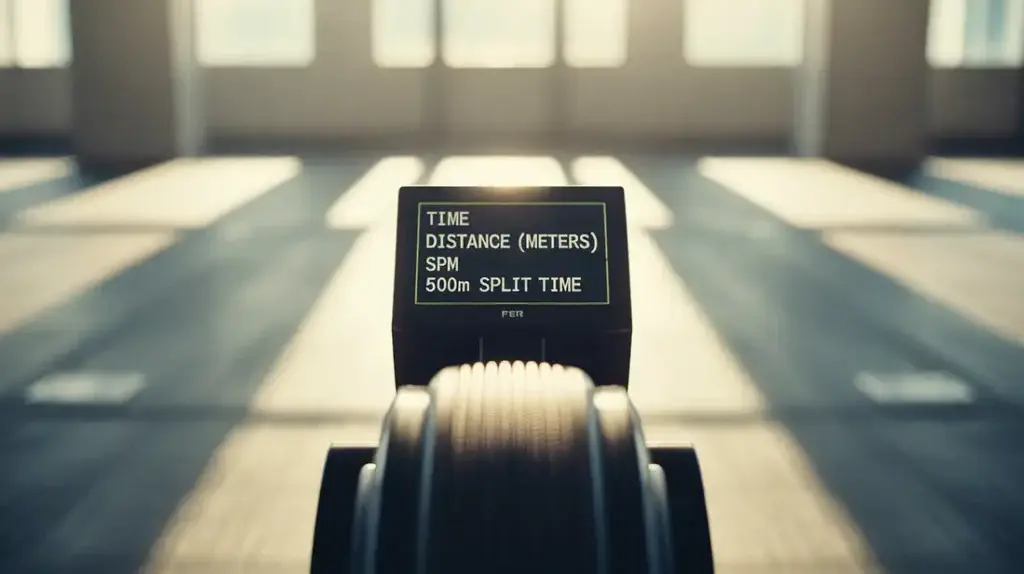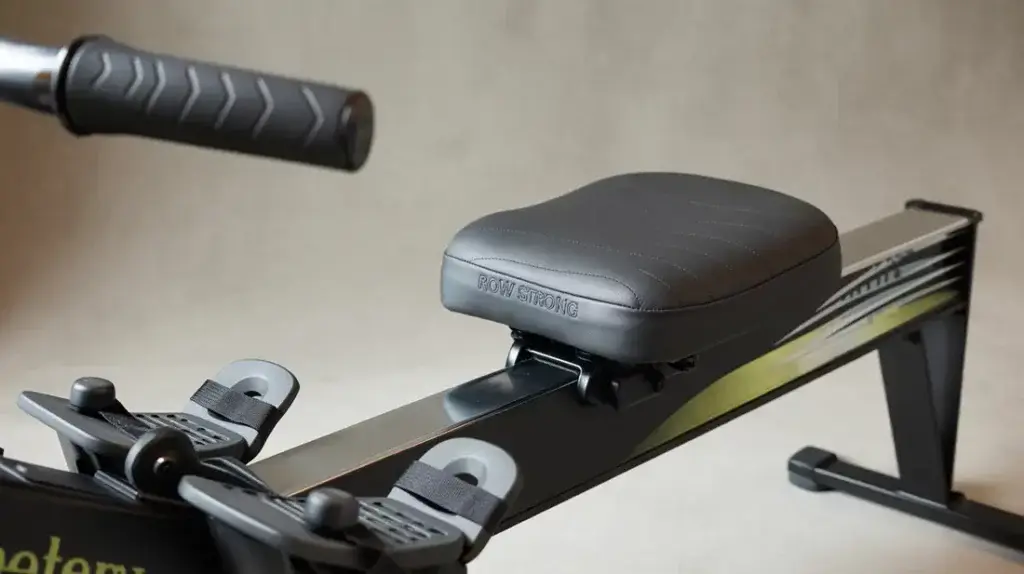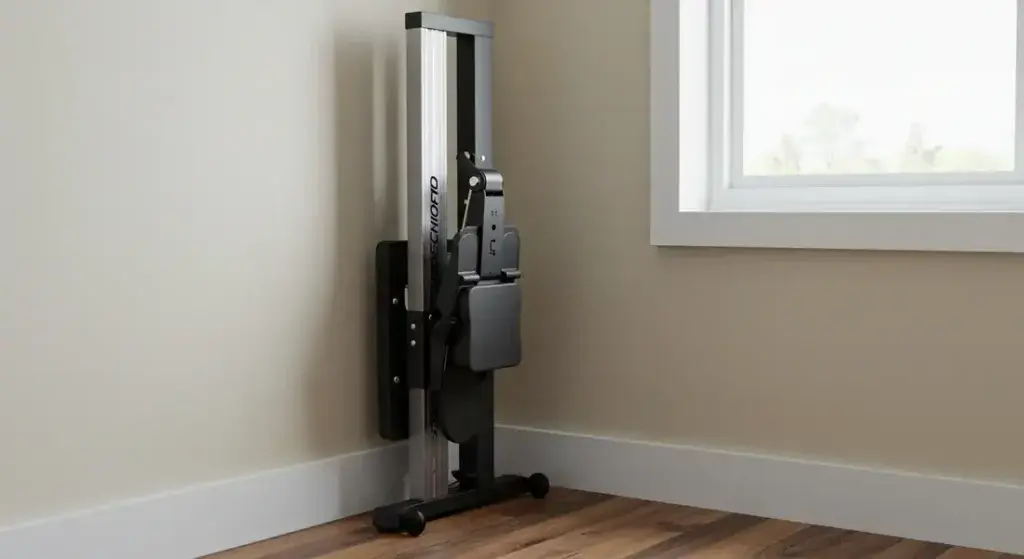You’ve decided a rowing machine is your path to a fantastic full-body workout – great choice!
You might even have an idea of the different types of rowing machines available.
But now, as you browse models, you’re bombarded with terms like “SPM,” “rail length,” “damper settings,” and “ergonomic design.”
It can feel overwhelming!

Don’t worry, we’re here to cut through the jargon. This guide focuses on the key rower features that truly matter for a beginner.
Understanding these will empower you to choose a machine that’s not just effective, but also comfortable, practical, and motivating for your home fitness journey.
Let’s look beyond the price tag and into the details that make a real difference.
Why These Rower Features Matter (Especially for Beginners)
For a beginner, the right features can be the difference between a rowing machine that gathers dust and one that becomes a beloved part of your routine.
Prioritizing correctly means you’ll invest in a machine that:
- Supports Good Form: Preventing injury and maximizing workout effectiveness.
- Keeps You Motivated: Through clear feedback and comfortable use.
- Fits Your Lifestyle: Considering space, noise, and ease of use.
- Grows With You: Offering enough challenge as your fitness improves.
Let’s break down the most important features to scrutinize.
1. The Monitor / Console – Your Window to Progress
The monitor is more than just a screen; it’s your coach, data analyst, and motivator all in one.
For beginners, a clear and user-friendly console is vital.

Essential Data Points to Look For
- Time: The duration of your workout – fundamental for tracking session length.
- Distance: Typically measured in meters. Setting distance goals can be very motivating.
- Strokes Per Minute (SPM): Your rowing pace or rate. Beginners often start around 18-24 SPM, focusing on technique.
- Split Time (e.g., /500m): This is a crucial metric in rowing. It shows how long it would take you to row 500 meters at your current pace. It’s the standard way to compare intensity across different workouts or rowers.
- Calories Burned (Estimate): A good motivator, though remember these are estimates.
- (Optional but good) Total Strokes: Can be interesting to track accumulated work.
Nice-to-Have Monitor Features (But Not Essential at First)
- Pre-set Workout Programs: Can add variety and guidance once you’re comfortable with basic rowing.
- Heart Rate Monitoring: Either via built-in grip sensors (less accurate) or compatibility with a chest strap (more accurate).
- Connectivity (Bluetooth/ANT+): Allows syncing with fitness apps like Fitbit, Strava, or dedicated rowing apps for more detailed tracking and community features.
- Power Output (Watts): A more advanced metric but very useful for gauging true effort.
Readability & Usability
- Screen Size & Clarity: Can you easily read the numbers while rowing? Is it backlit if you’ll row in dim light?
- Intuitive Controls: Are the buttons easy to understand and use? You don’t want to be fumbling with complex menus mid-workout.
- Adjustable Angle: Can you tilt the monitor for optimal viewing?
Beginner Tip: Don’t get swayed by a monitor boasting dozens of obscure features. Prioritize clear display of the essential metrics. A simple, reliable monitor is better than a complicated, confusing one.
2. Resistance System & Levels – Finding Your Challenge
We covered the four main types of resistance – Air, Magnetic, Water, and Hydraulic – in detail separately.
Here, we’re focusing on what to look for within those systems as a feature.
Adjustability & Range
- Ease of Adjustment: How easily can you change the resistance? Is it a manual dial, a lever (like a damper on air rowers), or electronic buttons on the console?
- Number of Levels (for Magnetic/Hydraulic): Do they offer a good range, from very light (for warm-ups or very new beginners) to challenging enough for progression?
- Responsive Range (for Air/Water): While these adjust to your effort, the initial “feel” (damper on air, water level in tank) should be manageable and allow for building intensity.
Smoothness & Consistency
- Regardless of type, the resistance should feel smooth and consistent throughout the entire stroke. There shouldn’t be any jerking, lagging, or “dead spots.” This is crucial for effective training and injury prevention.
- A jerky resistance can disrupt your rowing technique and make the workout unpleasant.
Beginner Tip: For air rowers, a lower damper setting (e.g., 3-5 on a Concept2) is often recommended for beginners to focus on technique rather than just battling heavy “gearing.” For magnetic rowers, start at a lower level and gradually increase as you get stronger and more confident with your form.
3. Comfort is King – Features for an Enjoyable Row
If your rowing machine isn’t comfortable, you simply won’t use it regularly.
Don’t underestimate these ergonomic features:

The Seat
- Padding & Ergonomics: Is the seat adequately padded to support your sit bones during longer sessions? Is it ergonomically shaped to allow for proper movement?
- Smooth Glide: Does it roll smoothly and quietly along the rail? Any bumps or hitches will be distracting.
- Height from Floor: Some prefer a slightly higher seat for easier on/off, especially if they have mobility concerns.
The Handle
- Grip Comfort: Is the handle padded or ergonomically shaped for a comfortable, secure grip without causing blisters easily?
- Width: Is it wide enough for a natural hand position (typically shoulder-width apart or slightly wider)?
- Angle: Some handles have a slight ergonomic bend (e.g., 10 degrees) which many find more comfortable on the wrists and forearms.
Footrests & Straps
- Adjustability: Can the footrests be adjusted to accommodate different foot sizes and ensure the strap sits comfortably across the ball of your foot?
- Pivoting vs. Fixed: Some footrests pivot slightly, which can allow for a more natural ankle movement for some users. Others are fixed.
- Heel Cups: Deep heel cups help keep your feet secure.
- Strap Quality & Ease of Use: Are the straps easy to tighten and release? They need to hold your feet securely without cutting off circulation.
Rail Length & User Height
- The slide rail needs to be long enough to allow for full leg extension during the drive phase. Most standard rowers accommodate users up to 6’2″ – 6’5″, but always check the manufacturer’s specifications if you are particularly tall.
- A rail that’s too short will compromise your form and workout effectiveness.
Beginner Tip: If trying a rower in a store, sit on it, grip the handle, and go through the motions. Even a few minutes can reveal potential comfort issues.
4. Build Quality & Stability – Your Foundation for Safety
A sturdy, well-built rowing machine will feel safer, last longer, and provide a better overall experience.
Materials & Construction
- Frame Material: Steel or aluminum frames are common and generally offer good durability.
- Quality of Components: Check the feel of moving parts, welds, and fasteners. Does it feel solid or flimsy?
Maximum User Weight Capacity
- Always choose a rower with a maximum user weight capacity that comfortably exceeds your current weight. This indicates a more robust build.
Overall Stability
- During a vigorous rowing session, the machine should remain stable and not wobble, lift, or shift on the floor. Look for wide stabilizer feet, often with adjustable levelers.
5. Size, Footprint & Storage – Fitting Fitness into Your Home
Rowing machines can be sizeable, so practical considerations for your home are essential.

Assembled Dimensions (Length x Width x Height)
- Measure your available workout space before you buy. Remember to account for clearance around the machine for movement.
Foldability & Upright Storage
- Many popular rowers (especially air and some magnetic/water models) can be folded or separated into two pieces for easier storage, or tilted upright.
- Check how easy the folding mechanism is to use. Is it a one-person job?
Transport Wheels
- Built-in wheels make it much easier to move the rower around for storage or cleaning.
Beginner Tip: If space is a major constraint, prioritize models known for their compact storage. Hydraulic rowers are often the smallest, but some foldable air and magnetic rowers also store very efficiently.
Beyond the Core – Other Features to Consider
- Noise Level: As discussed in our Types of Rowers page, this can be a deal-breaker. Magnetic = quietest; Air = loudest.
- Warranty: A good warranty (e.g., 1-2 years on parts, 5+ years on frame) indicates the manufacturer’s confidence in their product.
- Assembly: Check reviews for how easy the rower is to assemble. Some come mostly pre-assembled, others require more effort.
Prioritizing Rower Features as a Beginner – A Quick Guide
| Feature Category | High Priority for Beginners | Medium Priority | Lower Priority (Initially) |
| Monitor/Console | Clear essential metrics (Time, Dist, SPM, Split) | Heart Rate, Basic Programs | Advanced Connectivity, Many Programs |
| Resistance | Smoothness, Easy basic adjustment | Wide range of levels for future growth | Highly specific resistance curves |
| Comfort | Good seat, Comfortable handle, Secure footrests | Ergonomic handle angle, Pivoting footrests | Premium upholstery |
| Build/Stability | Sturdy frame, Good max user weight | High-end materials | Aesthetic finishes |
| Storage/Size | Fits your space, Easy storage if needed | Lightweight for moving | Ultra-compact if space isn’t an issue |
| Noise | Matches your living situation (e.g., quiet) | – | – |
FAQs – Key Rower Feature Clarifications
- Q1: Do I really need a fancy monitor with lots of programs as a beginner?
- A: Not necessarily. As a beginner, the most important monitor functions are the clear display of essential metrics like time, distance, strokes per minute (SPM), and 500m split time. These help you track progress and stay motivated. While extra programs can add variety later, they aren’t crucial when you’re first learning form and building a base.
- Q2: If a rower is foldable, does that mean it’s less sturdy?
- A: Not always. Many high-quality, sturdy rowing machines are designed with excellent folding mechanisms that don’t compromise their stability when in use. Look for robust locking systems and read reviews focusing on stability for specific foldable models. Good engineering can provide both convenience and durability.
- Q3: How important is rail length if I’m of average height?
- A: Even for average height, adequate rail length is crucial for achieving a full and proper rowing stroke, particularly full leg extension. Most standard rowers cater well to average heights (e.g., 5’4″ to 6’2″). However, if you are near the shorter or taller end of average, or have particularly long legs for your height, it’s still wise to check the manufacturer’s recommended user height range for the specific model.
Conclusion – Choosing Features for a Future You’ll Enjoy
Selecting a rowing machine involves more than just picking a type; it’s about matching the specific key rower features to your individual needs, space, and goals as a beginner.
By focusing on a clear monitor, smooth and appropriate resistance, genuine comfort, solid build quality, and practical storage, you’ll invest in a machine that supports your fitness journey for years to come.
Don’t feel pressured to get a rower with every bell and whistle.
Often, mastering the basics on a machine with solid fundamental features is the best way to fall in love with rowing.
What features are most important to YOU in a rowing machine?
- Are there any features you’re still unsure about?
Let us know in the comments below!
Ready to put this knowledge to use?
- Revisit our Beginners Guide to Rowing Machines for the big picture.
- Explore specific Rowing Machine Reviews to see how these features play out in real models.
